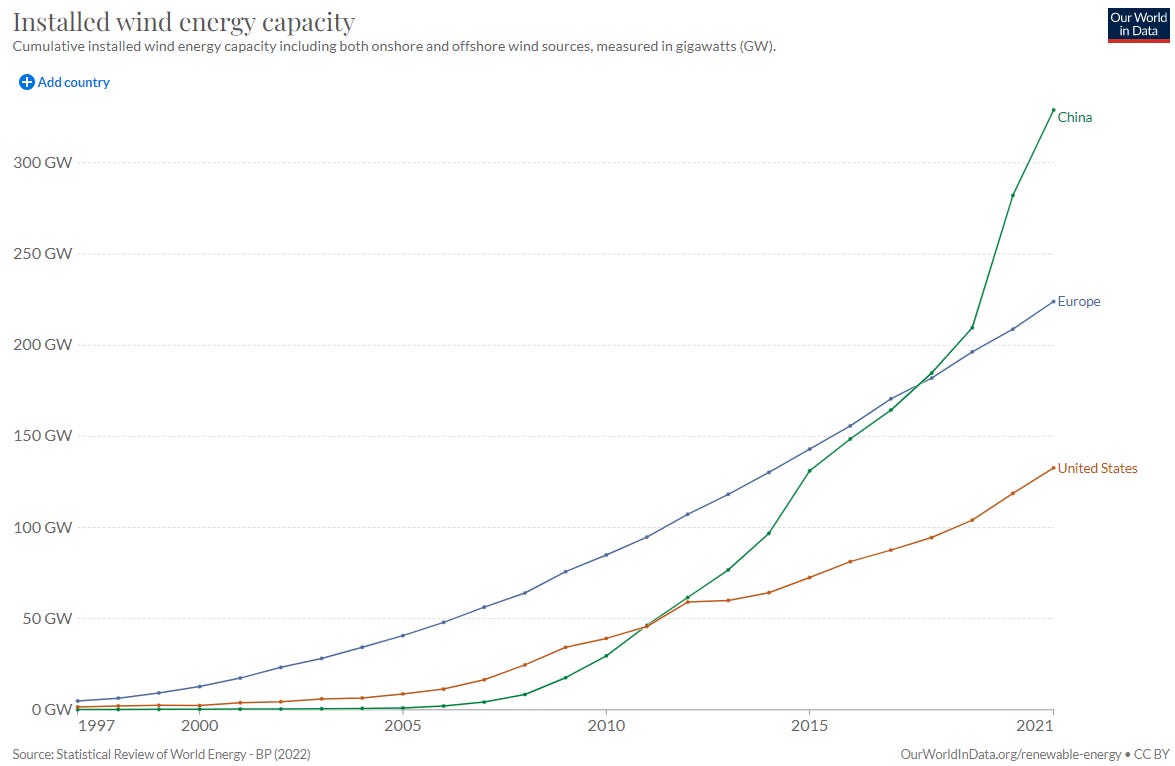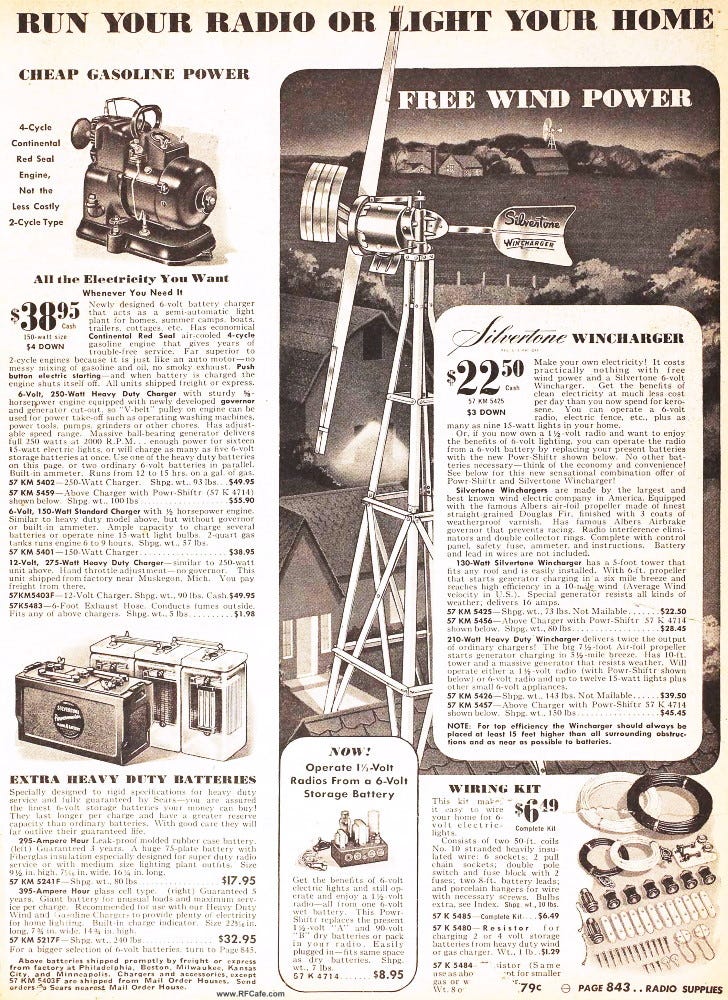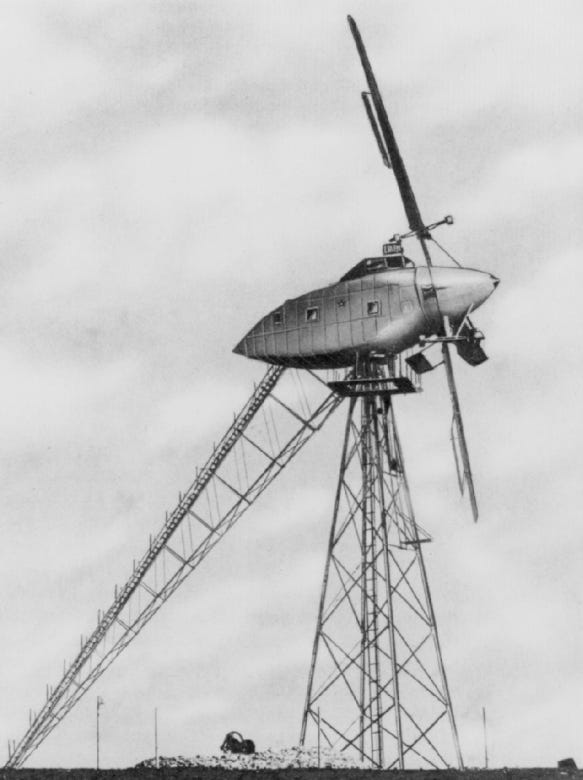Why Did We Wait so Long for Wind Power? Part I
(Slight detour in our economies of scale series)
Since the early 2000s, wind power has been a substantial fraction of new electricity capacity in the US. In 2020 wind power was 42% of new electricity generation capacity, and in 2021 it was 32%.
This is also true around the world. In Europe, wind power has been the first or second largest source of new generation capacity since at least 2015:
Likewise, in China wind power was the second largest source of new capacity in 2020. China currently leads the world in installed wind energy capacity:
Since the 1980s, the cost of wind-generated electricity has steadily fallen, to the point where it’s now one of the cheapest forms of electricity:
However, this is a relatively recent phenomenon. Prior to 1980 there was close to zero electricity generated from wind worldwide [0].
This is perhaps somewhat surprising in retrospect - unlike, say, nuclear energy or solar photovoltaics, the basic technology for wind-generated electricity (a windmill and an electric generator) has been in place since the 1800s. So why did it take over 100 years to start deploying it on a large-scale? Let’s take a look.
History of wind-generated electricity
The first mention of using wind to generate electricity is credited to William Thomson (better known as Lord Kelvin). In an 1881 address to the British Association for the Advancement of Science, Thomson noted that a windmill connected to a dynamo and a battery could be used to provide electric power, and speculated that, while wind had largely been superseded by steam generated by burning coal, “When the coal is all burned…it is most probable that windmills or wind-motors in some form will again be in the ascendant”.
It didn’t take long for windmills connected to electric generators to be built. James Blythe, a professor in Glasgow, built a windmill in 1887 that used a generator to charge batteries to power the lights in his vacation home. The same year a similar system was built in La Hève Cape in France to provide power to homes. In the US, inventor Charles Brush built a huge windmill to power the 350 lightbulbs in his Cleveland mansion in 1890. (For context, Edison patented his lightbulb in 1880, and the first central electric power station was built at Pearl Street in 1882). And in 1893, arctic explorer Fridjtjof Nansen commissioned a ship that included windmill powered electric lights for a voyage to the North Pole.

By the 1890s, there were several nascent commercial offerings for wind-generated electricity. The French La Heve system would be manufactured and sold by several companies in France and the US. In the US, companies such as Lewis Electric, Aermotor, and Fairbanks and Morse offered windmill electricity generating systems. In many cases these offerings came from companies that had previously sold more traditional windmills, such as Aermotor, which (along with hundreds of other manufacturers) sold the iconic American-style water-pumping windmill[1].
There were similar commercial efforts in England and Germany. However, none of these companies were successful, and by 1912 they had all ceased operations.
The most successful of early windmill-generated electricity efforts were those of Poul la Cour, a Danish professor and inventor who spent many years researching windmills and wind-generated electricity. La Cour built his first wind turbine in 1891, and later ran wind tunnel experiments, publishing a book of his research in 1900 explaining the design principles for wind-based electricity generation. La Cour licensed his designs to the firm Lykkegaard, and by 1910 there were over 100 Cour-designed wind turbines generating electricity in Denmark. Lykkegaard would continue to manufacture wind turbines into the 1940s.
Following WWI, research continued into wind-generated electricity. Previously, wind turbines had largely been based off of agricultural windmills. But while agricultural windmills were designed to provide torque and mostly spun slowly, efficiently generating electricity required the windmill blades to spin much faster. The rapid development of aircraft that had taken place during the war spilled over into wind turbines, and more efficient, faster-spinning twisted-airfoil shaped windmill blades were developed in Denmark, Germany, France, Russia and the US in the late 1910s and early 1920s. In 1919, German physicist Albert Betz established the “Betz Limit”, the maximum amount of energy a windmill could extract from the wind (approximately 59.3%), and in 1924 Oxford University began to perform wind energy experiments.
During this time, electricity generation capacity continued to increase in the US and Europe, but did so largely via the construction of hydroelectric and thermal combustion (coal, oil, and gas) centralized power stations - electricity production in hydroelectric and thermal plants in the US rose 36-fold from 1902 to 1929, going from 2507 kWh to 92,180 kWh. Electricity price continued to fall (the cost of coal-generated electricity fell by roughly 50% between 1900 and 1920), and the comparatively small amounts of intermittent power a wind turbine could generate didn’t seem to offer a particularly compelling alternative. As one commenter stated in 1931 [2]:
Even supposing that the efficiency of such a mill could be increased rather more than threefold, so that when driving an electric generator an output 10 kilowatts was obtained, some 16,000 of such windmills would be required to equal the output of the giant steam turbine installed at Hell Gate Power station in New York City…Taking these facts into consideration, also the difficulties due to uncertainty and irregularity of working…it will be seen that there is little prospect of developing power on an extensive scale by any known type of windmill.
However, centralized power stations required transmission lines to transport the electricity, which often didn’t extend into sparsely populated rural areas. The improving efficiency of wind turbines, combined with the benefits of electricity for powering lights, farm machinery, and, increasingly, radios, created a niche market for small wind turbines in rural areas that several manufacturers stepped in to fill.
In the 1920s and 1930s, US companies such as HEBCO, Aerolite, Wind King, and Wincharger sold wind-turbine electric systems. The most notable of these was the Jacobs Wind Electric Company, whose turbines became renowned for their performance and reliability (one was used on Admiral Byrd’s Antarctic expedition in 1932, and operated successfully for the next 22 years) - tens of thousands of Jacobs wind turbines were sold to rural customers in the 1930s, 40s, and 50s.
In addition, there were also hundreds of thousands of small wind turbines built specifically for powering radios or other small appliances. In 1945 the manager of the Wincharger corporation testified that 400,000 Winchargers had been sold around the world.
This wind power niche was largely eliminated in the US by the Rural Electrification Administration, which greatly expanded electrical transmission lines to reach rural areas. Between 1930 and 1950, the percentage of US farms with electricity service went from 10% to 80%. This made it impossible for the small wind turbine manufacturers to compete - a Jacobs wind turbine produced electricity at an annualized cost of $0.21 per kWh, 4 times higher than the $0.05 per kWh from the utilities. (This was not helped by the fact that as a precondition for getting connected to the grid, farms had to destroy any wind turbines they had installed). Jacobs Wind Electric Company closed operations in 1957 (though many of its wind turbines would continue to provide power well into the 1980s).
Australia, with its similarly expansive geography, also saw several commercial offerings for wind turbines for rural areas in the early to mid-20th century from companies like Hannan Brothers, Alston, and Dunlite. Demand for these likewise tapered off as Australian electrical infrastructure was built out, though Dunlite continued to sell turbines until the 1970s.
Utility scale power
Most early developments in wind-based electrical generation were focused on small-scale power generation for individuals and were generally only used when other sources of power were unavailable. In addition to its use in rural areas that lacked access to utility-provided electricity, wind turbines also saw increased use in Europe during WWI and WWII when other sources of fuel became scarce. During the world wars, Danish power stations often built windmills to be able to provide electricity in the absence of coal, oil, or diesel, and in England during WWII small wind turbines were often built on “windy British sites”. But when hostilities ended and other sources of fuel once again became available, interest in wind power waned.
The development of utility-scale wind power generation as a viable alternative to other sources of electricity proceeded much more slowly.
The first attempts at utility scale wind power took place in the Soviet Union. Like the US and Australia, the Soviet Union had an expansive geography, and wind power offered a potential alternative to constructing extensive transmission lines. Research had begun on wind power in the 1920s following instruction by Lenin, and by 1931 they had constructed a 100 kW turbine in Crimea that was successfully connected to the electrical grid. Plans were made for the construction of increasingly large turbines, culminating in a large, 5MW turbine. However, these plans were scrapped in the face of WWII, and it would take more than 60 years before turbines of that size would be built.
More speculative, but more ambitious utility scale plans were also investigated in interwar Germany. Engineer Hermann Honnef devised a plan for large-scale electricity generation using several enormous, 300-meter-tall turbines which would generate 20 MW each (for context, the largest wind turbines today have a capacity of around 15 MW). He received sufficient funding to build a small-scale test model in 1941, but these efforts were also ended by WWII.
In the US, the first attempt at utility scale generation was instigated by Palmer Putnam. Putnam, a former pilot and geologist, began studying large-scale wind power in the 1930s. He researched the Soviet and German efforts, and learned the finer points of turbine design from his neighbor Elisha Fales, who had developed airfoil-shaped windmill blades in the 1910s. He designed a large, 1.25 MW turbine and, with the help of Vannevar Bush, was able to secure funding from GE to get it constructed by the S. Morgan Smith company. By 1941 the Smith-Putnam turbine had been built on a peak in Vermont known as “Grandpa’s Knob”, generating power for the electrical grid of the Central Vermont Public Service Corporation (CVPCS). Mired by mechanical failures and reliability problems, the turbine operated for 1000 hours between 1941 and 1945 before a blade failure put it out of commission permanently.
Satisfied with the proof of concept, Putnam sketched out a plan for a large-scale wind-based utility plant - 20 turbines at 1.5 MW each. However, even with the most optimistic possible assumptions of costs, the estimated electricity price came in almost 50% higher than CVPCS would pay, and the plant was never built.
Wind vs cheap electricity
After WWII there continued to be sporadic development efforts for wind power. A few of the more notable ones:
Johannes Juul, a Danish engineer and student of Poul La Cour, obtained funding to build a large 200 kW turbine at Gedser in 1957. The turbine performed successfully until it was dismantled in 1967, but once again the cost wasn’t competitive - electricity from the Gedser turbine was close to twice as expensive as electricity generated from coal.
In the US, Percy Thomas of the Federal Power Commission (which would later become the Federal Energy Regulatory Commission, or FERC), spent a decade advocating for utility scale wind power. He authored several books on the topic, secured several patents for turbine designs, and worked with Arizona congressman John Murdock to get a bill authored in 1951 (House resolution 4286) that would have allocated $5 million for wind power research. However, the bill never made it out of committee, and Murdock was voted out of office in 1952, ending US government wind power efforts until the 1970s.
The British Electrical Research Association (ERA) tested a 100 kW wind turbine at St. Albans in 1952, and another in Costa Head, Scotland in 1953. Neither of these performed especially well - the Costa Head turbine only operated intermittently before being dismantled in 1955, and the St. Albans turbine proved much less efficient than hoped for, and was dismantled in 1957.
Similarly, in France the state utility company EDF funded several efforts at wind power research. The companies BEST and Neyrpic each built several small test turbines before attempting larger scale ones - BEST built a 800 kW turbine south west of Paris in 1958, and Neyrpic built a 1 MW turbine at Saint‐ Remy‐des‐Landes in 1963. Both turbines had numerous mechanical problems, and by 1964 neither were in operation.
In Germany, efforts were largely centered around Ulrich Hutter, an engineer who did his PhD research on wind-generated electricity. Hutter was hired by a German tool and farm equipment company Allgair, which was interested in expanding into the wind turbine market. Small Hutter-designed wind turbines were sold by Allgair in Germany through the 1950s, and a larger, 100 kW test turbine was built in 1957. However, Allgair eventually determined that the market for wind turbines was limited, and stopped producing them in 1960.
The OEEC (predecessor to the OECD) established a wind power research group in 1950, and held several meetings of member nations to discuss wind power. Meetings on wind power were also held in 1954 by UNESCO and the World Power Conference. In 1961, a UN Conference on New Sources of Energy would attract many wind power experts, including Juul, Hutter, and Jacobs.
These efforts gradually pushed the knowledge surrounding wind-generated electricity forward. Juul’s designs, for instance, were the first to use passive stall techniques to regulate turbine speed, and Hutter’s turbines were the first to use lightweight fiberglass wind turbine blades.
However, these efforts were ultimately derailed by the steady march of cheaper electricity. In 1882, Edison’s Pearl Street Station operated at a thermal efficiency of 2.5%. By 1920, steam turbines were operating at 20% efficiency, and by 1960 they had reached 40% efficiency. Fuel prices similarly fell - between 1949 and 1965 the real price of oil and coal fell by 20% and 33%, respectively. Larger power plants were able to capture greater economies of scale. Between 1920 and 1970 the cost of coal-generated electricity fell by approximately 80%.

Interest for alternative methods of energy production that did exist was almost entirely focused on nuclear power. Nuclear power, which coupled what had become large, reliable, and efficient steam turbines with (theoretically) nearly zero fuel costs, was the obvious candidate for the next generation of electricity generating technology, and governments around the world poured billions into nuclear energy R&D. In this environment, there appeared to be little point in further development of a small-scale, highly intermittent energy source, and most research efforts were canceled or wound down. Work on wind power that did continue was often thought to be most useful for developing countries that lacked electrical infrastructure [3].
However, a series of events in the 1970s - the energy crises and the environmental movement - would change the calculus for wind power.
This will continue with part II next week.
Footnotes
[0] - Our World in Data gives approximately 0.06 TWh of wind electricity generated in 1985. This is roughly 1/10,000th of the wind-generated electricity increase from 2020 to 2021 (approximately 500 TWh)
[1] - By 1900 more than a million iconic American-style mechanical windmills had been sold around the world.
[2] - “Power from Wind” pg 270
[3] - For instance, wind energy researcher Jos Beuskens stated “wind energy, like solar energy, in my view, could only play a significant role in developing countries, but was bound to remain marginal in the industrialised world”
Sources
The Wind Power Story: A Century of Innovation That Reshaped the Global Energy Landscape
Power from Wind: A History of Windmill Technology
The Rise of Modern Wind Energy
Wind Energy in America: A History












When I think of wind power, I remember the 1970s human powered flight challenges. Human powered aircraft had to be light, large, strong, flexible and make optimal use of limited power. The 1970s was the start of a materials revolution. There were all those lightweight fabrics and metals, low friction plastic bearings, power permanent magnets and sophisticated computer systems to design and control it all.
When I was in college, my class was asked why the ancient Romans couldn't build integrated circuits. They are largely made of silicon, something the Romans used all the time in the form of silicon dioxide in stone and sand. We wound up developing a technology tree with existing technology depending on earlier technologies and it was a pretty deep tree between 1970s era integrated circuits and anything the Romans could make.
Just as turbines had to wait for the materials and machining revolutions of the 19th century to play out, cost effective wind power had to rely on dozens, even hundreds of technologies. Looking at the computational technology alone, my personal viewpoint, is revealing. For a long time, even back in the 1990s, simulating the air flow around a helicopter blade was considered a distant reach for super-computing. Now it's standard practice. The finite element method for the support structures was being widely adopted, for example, to minimize materials in aluminum soda cans, but that wasn't the kind of thing one could do on a PC.
Then you have to deal with the compact generator, the blade control, and the ability to produce synchronized AC power. That meant new magnetic materials, new approaches to generator design, solid state power circuitry and what I can only call improved wind science. All told, it's been a pretty amazing trip.
Interesting that wind power is so cheap, but electricity so expensive in Europe and renewables-heavy US states.